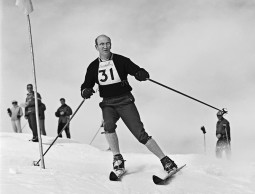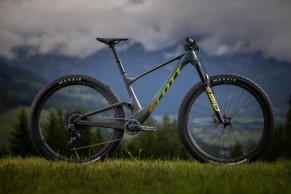Everything started with the invention of a ski pole: The history of SCOTT bikes
It went from skiing to cycling and has managed to revolutionise it. The history of SCOTT bikes started far away from the pedals, on the snow. Specifically, by developing an innovative ski pole that served as the basis for all of today's ski poles. And that pioneering spirit has not left them in any of their (many) reinventions: motocross, running and, above all, bikes. We take you on a journey to discover the many comings and goings of a now legendary company.

SCOTT and its aluminium revolution
Until the 1950s, ski poles were made from traditional materials: bamboo and steel. It took a visionary like Ed Scott, an engineer and competitive skier at the Sun Valley ski resort (Idaho), to change things. In 1958, he invented the first conical pole made of aluminium, much lighter and stiffer, which would soon become the standard. And it was the seed of what is now a multinational company with more than 1,000 employees around the world.
Soon, it moved on to other types of accessories for winter sports (boots, goggles...) and, in the 70s, it entered the world of motocross with the same type of accessories, as well as grips. But it was in 1986 when the leap that would forever mark the evolution of this company took place.
RECOMENDADO

At the cutting edge of cycling: handlebars, suspensions...
In the midst of mountain bike fever (a fever that came from California, but which was rapidly conquering Europe), the company took advantage of its American origin and its strong presence on this side of the pond to present its first bicycle. Although the absolute consecration would come three years later, in 1989, and with something unsuspected: a handlebar.
But not just any handlebar, of course, but perhaps the most famous handlebar in history. The Aero with which Greg LeMond entered the 1989 Tour de France to the laughter of the spectators because of its strange appearance, and which can practically be said to have won him the yellow in the final time trial in Paris. Yes, it was SCOTT that developed the father of all triathlete handlebars.

From then on, its engineers focused on developing innovations for cycling. One of the most important of these was the Unishock suspension, which arrived in 1991. In 1992, it launched one of the first MTBs with full suspension, and entered the equipment sector with their first helmets and shoes.
And in 1995 came another key moment: the launch of the Endorphin, the first large mass-produced carbon fibre mountain bike (the Lotus Sport may have been a few years earlier, but only 400 units were produced). With many World Cup and Olympic victories (it was ridden by the great José Antonio Hermida, who won his first World Cup with the SCOTT team in 1999), it cemented the brand's popularity as one of the best in the world.

The continuous development of SCOTT bicycles
In the late 1990s and early 2000s, the brand created the world's lightest bikes, breaking several records on several occasions. And in 2003, it introduced the first Genius, a milestone for its new full suspension concept with a shock absorber with three modes of operation: lockout, full travel and traction.
In 2006 they inaugurated with technical shoes what is today the fourth 'leg' of the company: running. And just a year later, in 2007, two of its most legendary models were born, still very present in its catalogue: Addict and Spark, which at the time was the lightest full suspension bike in the world.

And of course, the 2010s were no less full of advances. It started with the SCOTT Scale at only 899 grams (the lightest carbon MTB frame ever), with which Nino Schurter won his second World Cup, and with his first e-bikes, developed together with Bosch.
And in 2012, the Scale 700 and Genius 700 were to be the first mass-produced models with 27.5" wheels... And Nino Schurter dominated the season with one of the first ones, which contributed to their success. After introducing a line of cycling clothing and the Plasma 5 for triathlon and time trial in 2014, his breakthrough year in terms of sporting triumphs came in 2016: Schurter and Jenny Rissveds (both SCOTT-Odlo MTB Racing) won the gold medal at the Rio Games and the XCO World Championships in the same year.

SCOTT's promising present
Since the launch of the Foil Disc (a lightweight, aerodynamic road bike with disc brakes) in 2017, SCOTT has been primarily focused on refining its already wide range of models. The new Genius, Ransom or Addict RC have been there to prove it. In 2019, however, it returned to downhill with a 100% carbon bike, the Gambler.
But the truth is that this American brand rarely fails to innovate. So, this 2021, it has brought us the SCOTT Spark 2022, an XCO MTB with a hidden rear shock that makes history by eliminating any travel below 120mm (there is no option to ride less).
So where will they go in the future? While we can't answer that question with any certainty, looking at this abbreviated history of SCOTT bikes, with more and more innovations as the years go by, it's not hard to predict that it's going to be quite a bumpy ride. It promises to be, so keep an eye out for the 'next chapters'.





